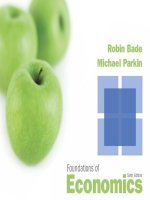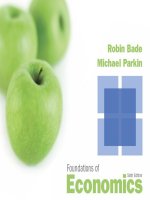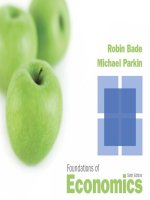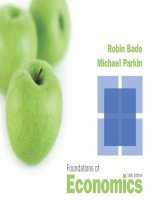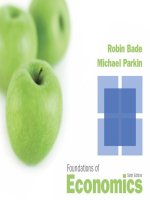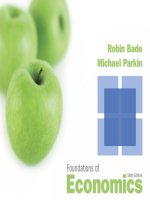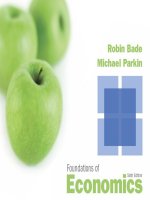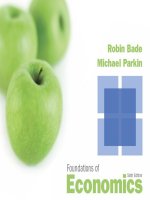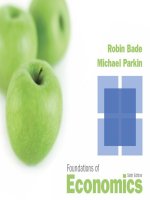Foundaions of economics 6th by robin bade ch04
Bạn đang xem bản rút gọn của tài liệu. Xem và tải ngay bản đầy đủ của tài liệu tại đây (3.07 MB, 65 trang )
© 2013 Pearson
Why did the price of coffee
soar in 2010 and 2011?
© 2013 Pearson
4
Demand and Supply
CHAPTER CHECKLIST
When you have completed your
study of this chapter, you will be able to
1 Distinguish between quantity demanded and demand,
and explain what determines demand.
2 Distinguish between quantity supplied and supply, and
explain what determines supply.
3 Explain how demand and supply determine price and
quantity in a market, and explain the effects of changes in
demand and supply.
© 2013 Pearson
COMPETITIVE MARKETS
A market is any arrangement that brings buyers and sellers
together.
A market might be a physical place or a group of buyers and
sellers spread around the world who never meet.
© 2013 Pearson
COMPETITIVE MARKETS
In this chapter, we study a competitive market that has so
many buyers and so many sellers that no individual buyer
or seller can influence the price.
© 2013 Pearson
4.1 DEMAND
Quantity demanded is the amount of a good, service,
or resource that people are willing and able to buy
during a specified period at a specified price.
The quantity demanded is an amount per unit of time.
For example, the amount per day or per month.
© 2013 Pearson
4.1 DEMAND
Law of Demand
Other things remaining the same,
• If the price of the good rises, the quantity
demanded of that good decreases.
• If the price of the good falls, the quantity
demanded of that good increases.
© 2013 Pearson
4.1 DEMAND
Demand Schedule and Demand Curve
Demand is the relationship between the quantity
demanded and the price of a good when all other
influences on buying plans remain the same.
Demand is illustrated by a demand schedule and a
demand curve.
© 2013 Pearson
4.1 DEMAND
Demand schedule is a list of the quantities
demanded at each different price when all the other
influences on buying plans remain the same.
Demand curve is a graph of the relationship between
the quantity demanded of a good and its price when all
other influences on buying plans remain the same.
© 2013 Pearson
4.1 DEMAND
© 2013 Pearson
4.1 DEMAND
Individual Demand and Market Demand
Market demand is the sum of the demands of all the
buyers in a market.
The market demand curve is the horizontal sum of the
demand curves of all buyers in the market.
© 2013 Pearson
4.1 DEMAND
© 2013 Pearson
4.1 DEMAND
Changes in Demand
Change in demand is a change in the quantity that
people plan to buy when any influence other than the
price of the good changes.
A change in demand means that there is a new
demand schedule and a new demand curve.
© 2013 Pearson
4.1 DEMAND
Figure 4.3 shows
changes in demand.
1. When demand
decreases, the demand
curve shifts leftward
from D0 to D1.
2. When demand
increases, the demand
curve shifts rightward
from D0 to D2.
© 2013 Pearson
4.1 DEMAND
The main influences on buying plans that change
demand are
• Prices of related goods
• Expected future prices
• Income
• Expected future income and credit
• Number of buyers
• Preferences
© 2013 Pearson
4.1 DEMAND
Prices of Related Goods
A substitute is a good that can be consumed in
place of another good.
For example, apples and oranges are substitutes.
The demand for a good increases, if the price of one
of its substitutes rises.
The demand for a good decreases, if the price of
one of its substitutes falls.
© 2013 Pearson
4.1 DEMAND
A complement is a good that is consumed with
another good.
For example, ice cream and fudge sauce are
complements.
The demand for a good increases, if the price of
one of its complements falls.
The demand for a good decreases, if the price of
one of its complements rises.
© 2013 Pearson
4.1 DEMAND
Expected Future Prices
A rise in the expected future price of a good increases
the current demand for that good.
A fall in the expected future price of a good decreases
current demand for that good.
For example, if the price of a computer is expected to
fall next month, the demand for computers today
decreases.
© 2013 Pearson
4.1 DEMAND
Income
A normal good is a good for which the demand
increases if income increases and demand decreases
if income decreases.
An inferior good is a good for which the demand
decreases if income increases and demand increases
if income decreases.
© 2013 Pearson
4.1 DEMAND
Expected Future Income and Credit
When income is expected to increase in the future, or when
credit is easy to get and the cost of borrowing is low, the
demand for some goods increases.
When income is expected to decrease in the future, or when
credit is hard to get and the cost of borrowing is high, the
demand for some goods decreases.
Changes in expected future income and the availability and
cost of credit has the greatest effect on the demand for big
ticket items such as homes and cars.
© 2013 Pearson
4.1 DEMAND
Number of Buyers
The greater the number of buyers in a market, the
larger is the demand for any good.
Preferences
When preferences change, the demand for one item
increases and the demand for another item (or items)
decreases.
Preferences change when:
• People become better informed.
• New goods become available.
© 2013 Pearson
4.1 DEMAND
Change in Quantity Demanded Versus
Change in Demand
A change in the quantity demanded is a change
in the quantity of a good that people plan to buy that
results from a change in the price of the good.
A change in demand is a change in the quantity that
people plan to buy when any influence other than the
price of the good changes.
© 2013 Pearson
4.1 DEMAND
Figure 4.4 illustrates and summarizes the distinction.
© 2013 Pearson
4.2 SUPPLY
Quantity supplied is the amount of a good, service,
or resource that people are willing and able to sell
during a specified period at a specified price.
The Law of Supply
Other things remaining the same,
•If the price of a good rises, the quantity supplied
of that good increases.
•If the price of a good falls, the quantity supplied of
that good decreases.
© 2013 Pearson
4.2 SUPPLY
Supply Schedule and Supply Curve
Supply is the relationship between the quantity
supplied of a good and the price of the good when all
other influences on selling plans remain the same.
Supply is illustrated by a supply schedule and a supply
curve.
© 2013 Pearson
